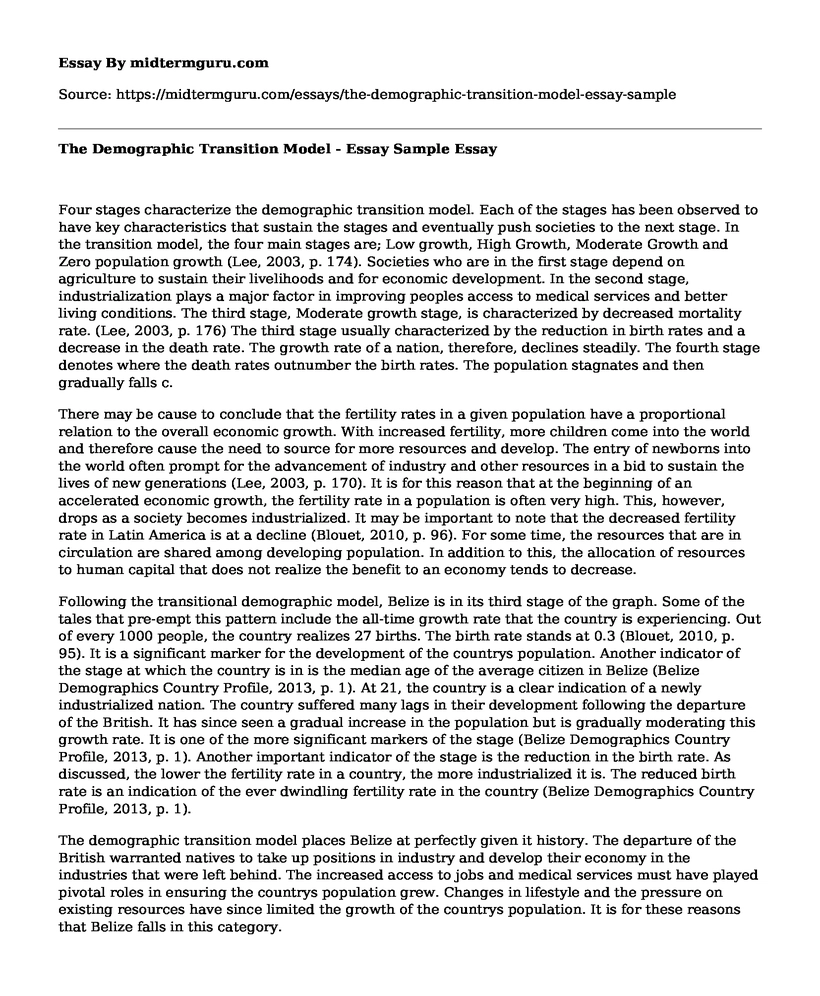Four stages characterize the demographic transition model. Each of the stages has been observed to have key characteristics that sustain the stages and eventually push societies to the next stage. In the transition model, the four main stages are; Low growth, High Growth, Moderate Growth and Zero population growth (Lee, 2003, p. 174). Societies who are in the first stage depend on agriculture to sustain their livelihoods and for economic development. In the second stage, industrialization plays a major factor in improving peoples access to medical services and better living conditions. The third stage, Moderate growth stage, is characterized by decreased mortality rate. (Lee, 2003, p. 176) The third stage usually characterized by the reduction in birth rates and a decrease in the death rate. The growth rate of a nation, therefore, declines steadily. The fourth stage denotes where the death rates outnumber the birth rates. The population stagnates and then gradually falls c.
There may be cause to conclude that the fertility rates in a given population have a proportional relation to the overall economic growth. With increased fertility, more children come into the world and therefore cause the need to source for more resources and develop. The entry of newborns into the world often prompt for the advancement of industry and other resources in a bid to sustain the lives of new generations (Lee, 2003, p. 170). It is for this reason that at the beginning of an accelerated economic growth, the fertility rate in a population is often very high. This, however, drops as a society becomes industrialized. It may be important to note that the decreased fertility rate in Latin America is at a decline (Blouet, 2010, p. 96). For some time, the resources that are in circulation are shared among developing population. In addition to this, the allocation of resources to human capital that does not realize the benefit to an economy tends to decrease.
Following the transitional demographic model, Belize is in its third stage of the graph. Some of the tales that pre-empt this pattern include the all-time growth rate that the country is experiencing. Out of every 1000 people, the country realizes 27 births. The birth rate stands at 0.3 (Blouet, 2010, p. 95). It is a significant marker for the development of the countrys population. Another indicator of the stage at which the country is in is the median age of the average citizen in Belize (Belize Demographics Country Profile, 2013, p. 1). At 21, the country is a clear indication of a newly industrialized nation. The country suffered many lags in their development following the departure of the British. It has since seen a gradual increase in the population but is gradually moderating this growth rate. It is one of the more significant markers of the stage (Belize Demographics Country Profile, 2013, p. 1). Another important indicator of the stage is the reduction in the birth rate. As discussed, the lower the fertility rate in a country, the more industrialized it is. The reduced birth rate is an indication of the ever dwindling fertility rate in the country (Belize Demographics Country Profile, 2013, p. 1).
The demographic transition model places Belize at perfectly given it history. The departure of the British warranted natives to take up positions in industry and develop their economy in the industries that were left behind. The increased access to jobs and medical services must have played pivotal roles in ensuring the countrys population grew. Changes in lifestyle and the pressure on existing resources have since limited the growth of the countrys population. It is for these reasons that Belize falls in this category.
References
Belize Demographics Country Profile (2013). Belize.com. Retrieved 1 February 2017, from https://www.belize.com/belize-demographics
Blouet, B. & Blouet, O. (2010). Latin America and the Caribbean (1st ed.). Hoboken, NJ: Wiley.
Lee, R. (2003). The Demographic Transition: Three Centuries of Fundamental Change. Journal Of Economic Perspectives, 17(4), 169-190. Retrieved from http://www.economie.ens.fr/IMG/pdf/lee_2003.pdf
Cite this page
The Demographic Transition Model - Essay Sample. (2021, Jun 01). Retrieved from https://midtermguru.com/essays/the-demographic-transition-model-essay-sample
If you are the original author of this essay and no longer wish to have it published on the midtermguru.com website, please click below to request its removal:
- Paper Sample on Archaic Adaptations
- Paper Example on Solar System Exploration
- Euler's Contributions to the Modern Day Mathematics Essay
- Discovering the Universe - Paper Example
- Paper Example on Physical Anthropology
- Japanese Food: Geography and History Matter! - Essay Sample
- Teaching Algebraic Expressions: Overcoming Challenges in Maths - Essay Sample







